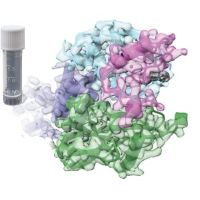Specification
| Description | Recombinant protein from the full-length sequence of Homo sapiens ubiquitin conjugating enzyme E2 K (UBE2K), transcript variant 3 (NM_001111113). |
| Organism | Homo sapiens (Human) |
| Expression Host | Human Cells |
| Tag Info | His or DYKDDDDK. Please contact us if you need further information or require specific designed tag. |
| Purity | Greater than 90% by SDS-PAGE gel |
| Uniprot ID | P61086 |
| Entry Name | UBE2K_HUMAN |
| Gene Names | UBE2K HIP2 LIG |
| Alternative Gene Names | HIP2 LIG |
| Alternative Protein Names | Ubiquitin-conjugating enzyme E2 K (EC 2.3.2.23) (E2 ubiquitin-conjugating enzyme K) (Huntingtin-interacting protein 2) (HIP-2) (Ubiquitin carrier protein) (Ubiquitin-conjugating enzyme E2-25 kDa) (Ubiquitin-conjugating enzyme E2(25K)) (Ubiquitin-conjugating enzyme E2-25K) (Ubiquitin-protein ligase) |
| Application | Antigens, Western, ELISA and other in vitro binding or in vivo functional assays, and protein-protein interaction studies; For research & development use only! |
| Buffer | Purified protein formulated in a sterile solution of PBS buffer, pH7.2, without any preservatives |
| Endotoxin | Endotoxin level is < 0.1 ng/µg of protein (<1EU /µg) |
| Length | 200 |
| Molecular Weight(Da) | 22407 |
| Protein Sequence | (The sequence of expressed protein may have some variation from the sequence shown below. Please contact us for the exact sequence.) MANIAVQRIKREFKEVLKSEETSKNQIKVDLVDENFTELRGEIAGPPDTPYEGGRYQLEIKIPETYPFNPPKVRFITKIWHPNISSVTGAICLDILKDQWAAAMTLRTVLLSLQALLAAAEPDDPQDAVVANQYKQNPEMFKQTARLWAHVYAGAPVSSPEYTKKIENLCAMGFDRNAVIVALSSKSWDVETATELLLSN |
Background
| Function | FUNCTION: Accepts ubiquitin from the E1 complex and catalyzes its covalent attachment to other proteins. In vitro, in the presence or in the absence of BRCA1-BARD1 E3 ubiquitin-protein ligase complex, catalyzes the synthesis of 'Lys-48'-linked polyubiquitin chains. Does not transfer ubiquitin directly to but elongates monoubiquitinated substrate protein. Mediates the selective degradation of short-lived and abnormal proteins, such as the endoplasmic reticulum-associated degradation (ERAD) of misfolded lumenal proteins. Ubiquitinates huntingtin. May mediate foam cell formation by the suppression of apoptosis of lipid-bearing macrophages through ubiquitination and subsequence degradation of p53/TP53. Proposed to be involved in ubiquitination and proteolytic processing of NF-kappa-B; in vitro supports ubiquitination of NFKB1. In case of infection by cytomegaloviruses may be involved in the US11-dependent degradation of MHC class I heavy chains following their export from the ER to the cytosol. In case of viral infections may be involved in the HPV E7 protein-dependent degradation of RB1. {ECO:0000269|PubMed:10634809, ECO:0000269|PubMed:10675012, ECO:0000269|PubMed:16714285, ECO:0000269|PubMed:16868077, ECO:0000269|PubMed:17873885, ECO:0000269|PubMed:19906396, ECO:0000269|PubMed:20061386, ECO:0000269|PubMed:8702625}. |
| Pathway | Protein modification; protein ubiquitination. |
| Protein Families | Ubiquitin-conjugating enzyme family |
| Tissue Specificity | Expressed in all tissues tested, including spleen, thymus, prostate, testis, ovary, small intestine, colon, peripheral blood leukocytes, T-lymphocytes, monocytes, granulocytes and bone marrow mononuclear cells. Highly expressed in brain, with highest levels found in cortex and striatum and at lower levels in cerebellum and brainstem. {ECO:0000269|PubMed:10634809, ECO:0000269|PubMed:10675012, ECO:0000269|PubMed:8702625}. |
QC Data
| Note | Please contact us for QC Data |
| Product Image (Reference Only) |  |

